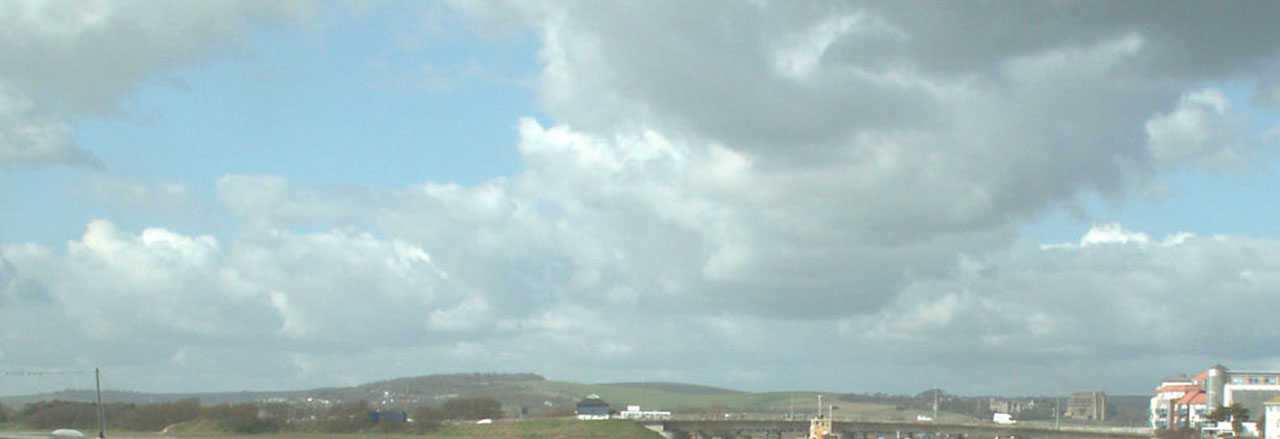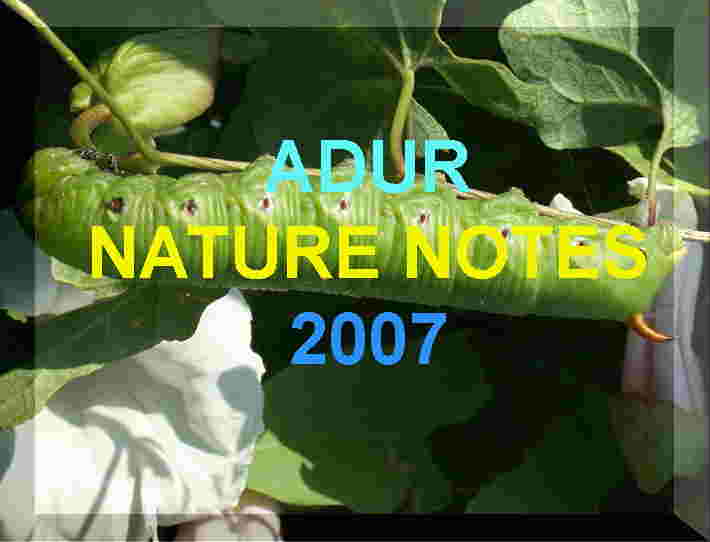|
LOCAL
NATURE RESERVES

A
Nature
Reserve is defined in Section 15 of
the National Parks and Access to the Countryside Act 1949,
as land managed for the purpose:
(a)
of providing, under suitable conditions and control, special opportunities
for the study of, and research into, matters relating to the flora and
fauna of Great Britain and the physical conditions in which they live,
and for the study of geological and physiographical features of special
interest in the area; or
(b)
of preserving flora, fauna, or geological or physiographical features of
special interest in the area; or for both these purposes.’ |
WILDLIFE
REPORTS
Link
to the Adur Wildlife Reports for 2011
3 December
2010
At
7:00
pm the air temperature had fallen further
to minus 9.7 °C, the
lowest temperature recorded since February
1983. The wind had receded to negligible from
the north.
Shoreham
Weather 2010
Met
Office: Shoreham
Previous
Lowest Temperature this Millennium
2 December
2010
Snow
fell over night in a Gentle Breeze (Force
3) that blew in from the
NNE at 8 mph.

On the
west-facing slopes of Mill Hill the snow
depth was measured at 190 mm
and in areas exposed to the north-easterlies the average depth could reach
230
mm.The pavement depth of snow was measured
at
155 mm at
10.00
am. The air temperature at 8:00
am was minus
3.8 °C.
 3
November 2010 3
November 2010
Three
medium-sized
Yellow-footed
Solitary
Bees, Lasioglossum xanthopum, visited the flowers of
the Musk Thistles on
a cleared patch on the lower slopes of Mill
Hill above the path.
Adur
Solitary Bees
Adur
Thistles
30
September 2010
At
lunchtime an Osprey
flew over the River Adur by Shoreham
Airport. I watched it for about ten minutes before it was mobbed by
some Crows.
It dived into the river twice but didn't appear to catch anything.
19
September 2010
Five
Kestrels
soared over Mill Hill around 1:00
pm. At least three of them and possibly all
of them were thought to be juvenile birds although they were adult sized.
18
September 2010

This
small bird of prey was photographed in a favourite haunt of mine at Southwick
Hill (north side), down to Whitelot Bottom, up again towards Thundersbarrow
(north of east Shoreham). This was a Kestrel
(although I first thought it was a Merlin).
12
September 2010

|

|
Clouded
Yellow and
Meadow
Brown
|
Clouded
Yellow and
Musk
Thistle
|
Mill
Hill is proving to be a draw for butterfly
enthusiasts wanting to photograph the two Clouded
Yellows that appeared in the afternoon.
I managed some superb photographs as the cloud cover encouraged the butterflies
to remain still.
9
September 2010
The
6.9 metre equinoctial spring tide at 12:35
pm lapped against
the riverbank at Old Shoreham which had the result of compelling the three
species of grasshoppers
that normally occupy the high tide strandline
and Orache zone
into
a thin line of vegetation between the
River
Adur and the cyclepath and hundreds of
them could easily be disturbed. Two Buzzards
glided from east to west over Mill Hill
and rose on the thermals and circled over the hill for five minutes (about
2:15 pm) before becoming smaller and smaller
as they rose higher and higher and then they flew off. Two immigrant Clouded
Yellow Butterflies flew rapidly from one
end of the lower slopes of Mill Hill to the other and back again.
Full
Butterfly Report
Mill
Hill was alive with butterfly activity. There are still some good Adonis
Blues
but I concentrated on two male Clouded
Yellows that were patrolling the slopes.
They met and fought many times, twirling up over the hill. Close ups required
a lot of running around the hill in pursuit and hoping the landing lasted
more than a few seconds. They seemed to nectar on most of the flowering
plants on the hill. A Hedge Rustic Moth,
Tholera
cespitis,
was spotted in the
undergrowth.
Adur Moths
8
September 2010
At
the northern end of the lower slopes of Mill
Hill, I surprised a fat Adder
which quickly slithered off into the undergrowth. Later, it returned to
the same spot and was photographed coiled up under the sun that shined
intermittently through the clouds. This is
the first report of an Adder
on Mill Hill on these Nature Notes pages. Previously
they had only be reported from Lancing
Ring.
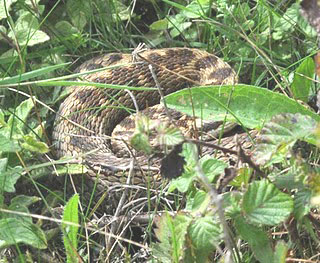 |
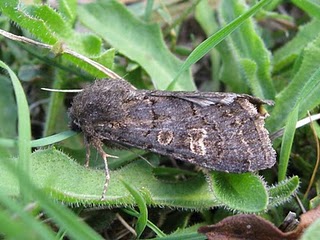
|
|
Adder
|
Dark Sword-grass
|
I spotted
a distinctive flash of orangey-yellow and I watched a Clouded
Yellow Butterfly patrolling his territory.
I was never able to get near enough to spot exactly where he landed, but
I had a great view of him flying methodically around his territory looking
for a female.
4
September 2010
Over
the Old Erringham pasture I had a very clear view of the underside of a
Buzzard
gliding down from over Erringham Hill,
the first time I had such a good view of this raptor ever.
28
August 2010
Six
Buzzards
soared over Lancing Ring.
18
August 2010
Out
on a hedgerow foraging trip I spotted my first confirmed Brown
Hairstreak on the southern bank of the
Buckingham
Cutting, north Shoreham, which has made me more confident about my
two previous sightings
on Mill Hill. It was a male in an area
where Blackthorn
bushes were not known but it is so overgrown that they may occur.

|

|
|
Brown
Hairstreak
|
Speckled
Woods
|
A couple
of Speckled Woods
were seen attempting to mate on the bush next to the Brown
Hairstreak and I think this may also be a
first time I have seen this. On the garden sized area of the south-western
part of Mill Hill Cutting there were 21 Chalkhill
Blues
including eight females.
Butterfly
& Moth List 2010
12
August 2010
Over
the shingle near the Old Fort,
Shoreham
Beach, the white rear of a Wheatear
was easily spotted as it flew around prior to emigration south.

|

|
|
Adonis
Blue
|
Common
Blue Butterfly
|
9 August
2010
Sometimes
a cloudy overcast day is good for photographing butterflies
as they may remain still for just that fraction longer. On the lower slopes
of Mill Hill, 68 male Chalkhill
Blues and 53 male Adonis
Blues were recorded in the 1.2 acre transect
in 25 minutes. There were twelve Wall Browns
seen on Mill Hill, over 200 Common Blues
and
frequent Brown
Argus.
A Hornet Robber Fly landed
on Mill Hill.

|

|
|
Hornet
Robber Fly
|
Chalkhill
Blue & Adonis Blue
|
Twelve
butterfly species were seen in the middle of the day.
Full
Butterfly Report
2
August 2010
What
a difference a day makes: the half acre top meadow (north of the upper
car park) on Mill Hill was still alive
with butterflies, but the half acre now hosted only about a 120 Common
Blues, but they may have dispersed as
surrounding meadow areas were now more densely populated so the total on
the hill does not seem to have diminished in numbers. Brown
Argus
were
plentiful as I ever seen them with at least 30 positively recorded and
many more did a successful imitation of a Common
Blue female.
 |

|
|
Chalkhill
Blue
|
Wall
Brown
|
With
the sun finding a gap in the clouds there were reasonably good conditions
for butterfly watching on the parched downs.
I was not in the mood for recording the numbers, but I noted that the Chalkhill
Blues on
the lower slopes of Mill Hill were slightly less than the previous day,
but only 64 were recorded in the 20 minutes walk on the 1.2 acre transect,
which included just the five definite females.
In the weak sunshine, I spotted fourteen Wall
Browns seen on Mill Hill and my first
Small
Copper on Mill Hill this year.
Mill
Hill Report
Butterfly
& Moth List 2010
1
August 2010
Even
when the sun found a gap in the clouds not many more than a hundred Chalkhill
Blues were
disturbed on the one acre transect on the lower slopes of Mill
Hill. As there was not even spread over
the steeper slopes this extrapolated to mere 350 on Mill Hill. This is
a very low figure for the peak period.
 |
7432.jpg)
Common
Blue
(female)
|
In
excess of 700 Common Blue
Butterflies fluttered around and mated
in the one half acre meadow (north of the upper car park) on Mill Hill.
This
extrapolated to over 1500 on Mill Hill, possibly many more. Other
noteworthy observations were eight Wall
Browns on Mill Hill and the mating of
many Brown
Argus
Butterflies.
Fourteen
species of butterfly were noted.
Full
Butterfly Report
29
July 2010
On
an overcast a very mixed bag of a day, the highlight was the sudden rise
of a large light blue Emperor Dragonfly
from
the top part of McIntyres Field, the part of Lancing
Ring Nature Reserve now included in the South
Downs National Park. This dragonfly
is scarce locally and not seen every year.
28
July 2010
With
three days before the peak emergence of Chalkhill
Blue Butterflies on Mill
Hill would be expected, the numbers are extremely poor with just 49
males
recorded on the lower slopes transect on a cloudy day. The first second
brood male
Adonis Blue
was noted on the lower slopes, with five Wall
Browns amongst
17 species of butterfly seen on Mill Hill and its approaches.
Male Common
Blue Butterflies
were almost as frequent
as the Chalkhill Blues
on the lower slopes of Mill Hill, and on the middle and upper slopes their
numbers exceeded 200. Females
of these three blue species were not noted, but the cloudy and breezy conditions
were well below optimum. Ten Small Blue
Butterflies still fluttered around on
the southern bank of the Buckingham Cutting.
20
July 2010
My
first Hummingbird Hawk-moth,
Macroglossum
stellatarum, of the year hovered/flitted
around a clump of Greater Knapweed
in the north-west corner of Frampton's Field, Old Shoreham, as seen from
the Pixie Path. On the lower slopes of Mill
Hill, the count of male Chalkhill Blues
were still a mere seventeen.
Butterfly
& Moth Report
19
- 20 July 2010
An astonishing
22
butterfly species were seen on the Lancing
Ring meadows over two days as follows:
|
Gatekeeper
|
Meadow
Brown
|
Marbled
White
|
Large
White
|
Red
Admiral
|
Peacock
|
|
Small
Copper
|
Small
Skipper
|
Essex
Skipper
|
Comma
|
Common
Blue
|
Holly
Blue
|
|
Small
Tortoiseshell
|
Brimstone
|
Small
Heath
|
Green-veined
White
|
Wall
Brown
|
Dark
Green Fritillary
|
|
Ringlet
|
Small
White
|
Speckled
Wood
|
Painted
Lady
|
|
|
One
small patch of Bramble
was unusually attractive to butterflies today with no less than 13 species
attracted to it in a 15 minute watch. This included a Dark
Green Fritillary which gave me some very
good close views and five Common Blues.
This
is the first positive record of a Dark
Green Fritillary on Lancing Ring on these
Nature Notes pages.
10
July 2010
At
Shermanbury
the freshwater reaches of the western River
Adur are more like a large slow flowing
stream, with plenty of vegetation including yellow Water
Lilies. Shoals of Rudd
with reddish fins could be seen in the surface waters with much smaller
silvery fish fry. By far the most impressive sight was the appearance of
frequent attractive male
Banded Demoiselles which were everywhere
and numbered in excess of thirty in a small area of river near the road
bridge. A large brown dragonfly
cruised repeatedly over the river, and it was much too large to be a Common
Darter.
Adur
Damsels & Dragonflies 2010
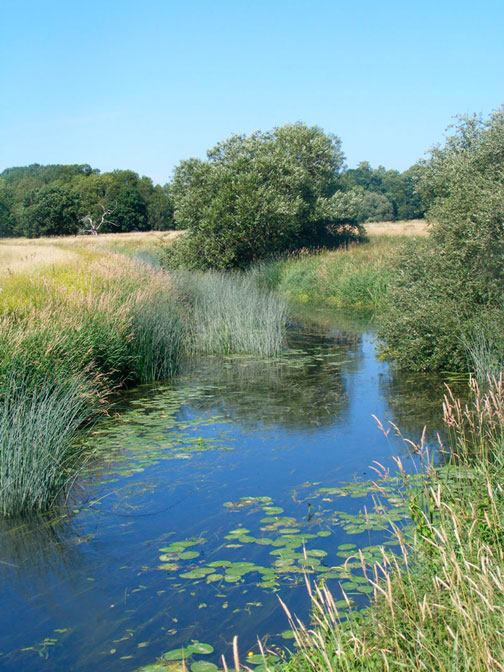 |

Silver-washed
Fritillary
|
At
Southwater
Woods, I recorded White
Admiral Butterflies and Silver-washed
Fritillaries for the first time this year.
Full
Butterfly & Moth Report
Adur
Levels
The
elusive White-letter
Hairstreaks were discovered in Kingston
Lane, Shoreham. Opposite the southern entrance to Shoreham Academy (formerly
Kings Manor School) there is a long line of Elms
on the east side of Kingston Lane (TQ 237
056). In the morning we saw two at the northern
end of these Elms
at
about
10:00 am
and then another about half way along. They spent the whole time flitting
round the canopy though I did see one settled through binoculars. These
are the first records of this butterfly on these web pages.
Also a Small Tortoiseshell
and then a first of the year Clouded Yellow
in Phoenix Way, Southwick.
Adur
Butterfly Flight Times
Adur
Butterflies: First Dates
 5
July 2010 5
July 2010
The
first Chalkhill Blue Butterfly
of the year was recorded at 11.06 am
on the lower slopes of Mill Hill. Five
Ringlet
Butterflies were recorded on the top of
Mill Hill for the first time. Seventeen different
butterfly
species were seen in a couple of hours.
Adur
Butterflies: First Dates
Full
Butterfly & Moth Report
9 June
2010
Summer
is nearly here! In the sunshine numerous (at least ten) wild plants were
seen in flower for the first time this
year.
Wild
Flower List
In
the meadow to the north of the upper car park on Mill
Hill, Common Blue
Butterflies flitted amongst the taller
herbs and it was here that I spotted my first Large
Skipper of the year. The
twelve species of butterfly were seen during the day.
 Full
Butterfly Report Full
Butterfly Report
Adur
Moths
Adur
Skippers
Adur
Butterflies: First Dates
8 June
2010
My
first Cinnabar Moth
of the year flitted amongst the grasses and herbs on the southern bank
of Buckingham Cutting, north Shoreham, where
about fifty Small Blue Butterflies were
immediately seen in
an area of five square metres in just two minutes.
Butterfly
and Moth Report
5 June
2010
Adur
World Oceans Day 2010
The
tenth Adur World Oceans Day went well in the
marquee on
Coronation
Green, by Shoreham
footbridge at the High Street end on the opening Saturday of the Adur
Festival. Len Nevell
of the British Marine Life Study Society was
there with the usual exhibition of lobsters and crabs.

"The
aim of the event is to introduce the young visitors to the world of the
sea
and seashore, an opportunity they may not get. It is an educational
event
with an opportunity for children to participate in the interactive
activities."
Quote
by Andy Horton (British Marine
Life Study Society)
30
May 2010
Two
more notable firsts of the year were three Silver
Y Moths, Burnet
Companion Moths and a Purple
Bar (a carpet moth) on Mill
Hill.
On
the transect 1.2 acres of the lower slopes the count in a timed 11 minutes
was 122 male Adonis Blues
and nine females,
including a mating pair. This count extrapolates
to about 350 Adonis Blues
on Mill Hill. Eleven species of butterfly
and three macro moths were seen in about an hour.
Full
Butterfly & Moth Report
Adur
Moth Report
23
May 2010
With
the sun coming out, so were the butterflies.
On Mill Hill, I stopped counting the Adonis
Blues at a hundred males and handful of
females. Fourteen species in a couple of hours
was the most variety seen in a day this year. The
tally included my first Small Heaths
of the year, a Green Hairstreak losing itself amongst The Horseshoe
Vetch and a Wall
Brown seen in the same area (near the
copse at the top of Mill Hill) for the last seven years. Over the Waterworks
Road, (Old Shoreham), the first female
Broad-bodied
Chaser (dragonfly),
Libellula
depressa, of
2010
cruised above my head, and the four white butterflies seen there were females
of the Orange-tip.
Full
Butterfly Report
21
May 2010
My
first shrimping
outing of the year using my smaller three foot wide shrimp net on the medium
tide
on Lancing Beach (Widewater West) yielded a rather poor 30 or so Brown
Shrimps,
Crangon crangon,
and a notable young Turbot,
Psetta
maxima.
Full
Shrimping Report
14
May 2010
At
this time of year the St. Mark's Flies,
Biblio,
make a bit of a nuisance of themselves and they were common on and around
the
Buckingham Cutting (at the top of The
Drive, Shoreham) although not so common on Mill
Hill.
Twelve species of butterfly were
seen in a couple of hours of weak sunshine
including my first
Wall Brown Butterfly
of the year, my first chocolate-brown female Adonis
Blue Butterfly,
my first Brown Argus,
and my first male Common Blue Butterflies
of the year, all on Mill Hill.
The
other species seen were a Small White,
frequent Large Whites,
a Green-veined White,
a male Orange-tip,
a Grizzled Skipper,
half a dozen Dingy Skippers,
occasional Holly Blues,
and frequent Speckled Woods.
Full
Butterfly Report
Adur
Butterflies: First Dates
 12
May 2010 12
May 2010
The
expanse of Horseshoe Vetch, Hippocrepis
comosa, was only just beginning on
the lower slopes of Mill Hill, visited
by 13 Dingy Skippers
and my first four male Adonis Blues
of the year.
Butterfly
Report 2010
10
May 2010
I
spotted my first Swallow
of the year flying over Victoria Road, Portslade. Later, in the early evening
a few more (at least two) Swallows
were seen over Middle Road in the residential part of Shoreham.
6 May
2010
Then
off across the bridge to Mill
Hill Nature Reserve
on the lower slope I spent two hours, 2.30
to 4.30 pm. I saw my first Adonis
Blue Butterfly
of the year, then I found three Green Hairstreaks,
three Small Coppers,
one Grizzled Skipper,
two
Orange Tips,
one Speckled Wood,
two Small Heaths,
lots of Dingy Skippers,
male and female Brimstones,
and Small Whites.
Adur
Butterflies: First Dates
23
April 2010
 The
first solitary flower of the Horseshoe
Vetch, Hippocrepis comosa,
appeared on the lower slopes of Mill Hill,
at least nine days later than last year.
The first solitary Milkwort was
also spotted. The
first solitary flower of the Horseshoe
Vetch, Hippocrepis comosa,
appeared on the lower slopes of Mill Hill,
at least nine days later than last year.
The first solitary Milkwort was
also spotted.
Flowering
Dates of Horseshoe Vetch
20
April 2010
In
the weak sunshine the first reptile of the year was spotted on the wall
of the Old Fort, Shoreham Beach: an adult
Wall
Lizard, Podarcis
muralis, (with an intact tail) skittered into a hole the
size of a flint cobble on the south-facing wall.
Adur
Lizards
21
March 2010
At
last I saw my first butterfly of the year:
a Red Admiral
flew
around the bridge over the A27
to Mill Hill.
Adur
Butterfly List 2010
3 March
2010
1 February
2010
There
was a large range of seven metre tides measured
by WXTide at Shoreham
Harbour (Kingston Beach), from 6.9
metres high to minus
0.1 metres below Chart
Datum.
BMLSS
Tides
10
January 2010
Walking
up to Beeding Hill from Shoreham was strenuous due to the
1.5 metre snow drifts but the blanket snow
cover in the fields demonstrated why so many inland birds are seeking shelter
in the river valleys and on the coast. There was a huge bunting flock on
Beeding Hill with at least 400 Corn Buntings,
90 Yellowhammers
and three Reed Buntings
feeding in a stubble field accompanied by 200 or so Skylarksand
20 Linnets.
RSPB
Corn Buntings
7 January
2010
Rabbits
spent a long time in the open fields on the levels east of Lancing
College, grazing on the snow covered pastures. Snow carpeted the countryside
averaging a depth of 95 mm
on Lancing Ring after the overnight snowfall.
At
9:00
am the air temperature fell to an over night
low of minus 6.1 °C. Birds
foraged in the open amongst the bare twigs and the snow;
about half a dozen Reed
Buntings were
particularly noticeable on the tideline of the River
Adur estuary south of the Toll
Bridge, with Meadow Pipits,
and a dozen more Reed Buntings
on the frozen pond by the road to Lancing College.
Full
Weather Report
A flock
of about twenty Fieldfares
visited North Farm Road in South Lancing feasting on the red
berries of a Cotoneaster
'Cornubia'
tree
in the Hamblett's
back garden. One of these northern thrushes
was seen to gobble up three berries
in quick succession.

|

|
|
Reed
Bunting
|
Fieldfare
|
In
severe winters these birds move south and from the countryside into the
parks and larger gardens.
RSPB
Fieldfares
6 January
2010
 A
steady flurry of light snow blew in from the east in a Moderate Breeze
(Force 5)
but the air temperature remained just above freezing. The ground temperature
must have been lower as the snowfall lasted for hours in the morning and
a small amount of snow (8 mm)
laid on the pavements of Shoreham. The downs
and countryside were covered to a similar depth, but in places this quickly
turned to slush. Pastures and arable fields were more sparsely covered,
negligible in lots of places. After dusk
there was a further snowfall. A
steady flurry of light snow blew in from the east in a Moderate Breeze
(Force 5)
but the air temperature remained just above freezing. The ground temperature
must have been lower as the snowfall lasted for hours in the morning and
a small amount of snow (8 mm)
laid on the pavements of Shoreham. The downs
and countryside were covered to a similar depth, but in places this quickly
turned to slush. Pastures and arable fields were more sparsely covered,
negligible in lots of places. After dusk
there was a further snowfall.
Shoreham
Weather 2010: Snow
|
